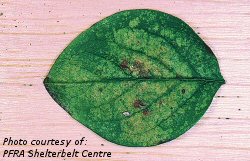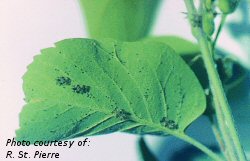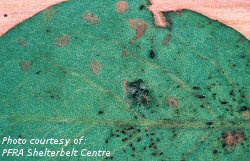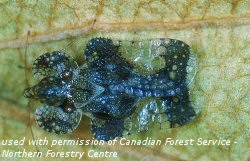Hawthorn Lace Bug (Corythucha Cydoniae)

Hawthorn lace bug damage

Hawthorn lace bug on underside of saskatoon

Hawthorn lace bug adult and frass

Hawthorn lace bug adult
Host Plants And Distribution
This species feeds on saskatoon and has been found in Manitoba and Saskatchewan. Other species of lace bugs may feed on saskatoon or chokecherry in other regions of Canada and the United States.
Biology
Lace bugs overwinter as adults and there are usually two generations per year. Adults are small (3 mm) bugs that appear to have a lace covering. The black eggs are laid in clusters on the underside of leaves in early spring and are easily visible. Nymphs emerge after about three weeks and feed on the underside of the leaves. There are five nymphal stages (instars) and the last stage is black with light markings. First-generation adults emerge in midsummer and the second generation completes its development in the fall. These insects feed by piercing the leaves with their mouthparts and sucking out plant juices.
Symptoms And Damage
Stippled or mottled leaves with many lace-winged insects present is the tell-tale sign of lace bug feeding. These insects feed in large numbers and stain leaves with their excrement. Damage by these insects is not considered to be of economic concern.
Scouting Techniques
As these insects do not cause economic levels of damage, scouting is unnecessary.
Economic Thresholds
No economic thresholds have been established for this insect. They do not cause economic levels of damage.

